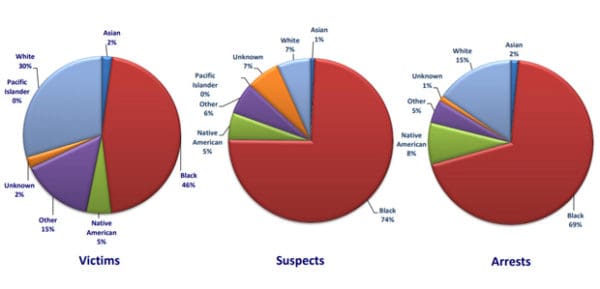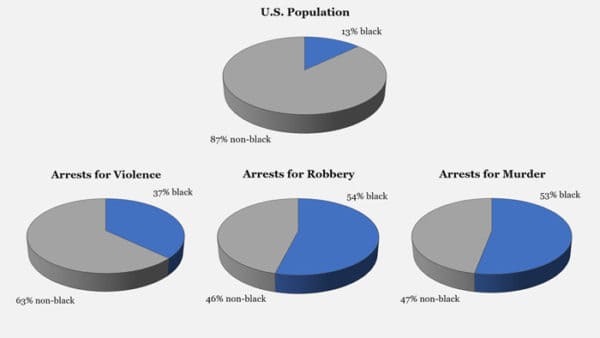Police Racism: A Manufactured Crisis
Jared Taylor, American Renaissance, June 5, 2020
Demonstrators have been deluded by the media.
This video is available on BitChute, Rumble, Brighteon, Gab TV, 3Speak, GVID, UGETube, and Nico Video.
The United States is in an uproar over the death of George Floyd at the hands of the Minneapolis police. There have been demonstrations in over 400 cities, and looting and arson in every major city. Why are so many people in the streets? Because they believe that American society is systematically racist and that the police brutalize and even casually murder black men.
The news constantly tells them the police are racist, and many people think the gruesome video of the death of George Floyd bears this out. But let’s look at the facts. Some may surprise you.
Police in America make 12 to 13 million arrests every year. How often does this lead to the death of an unarmed black person? We know the exact number, thanks to a Washington Post database of every killing by the police. No one else has better figures. So please stop and guess how many unarmed blacks are killed every year. Two hundred? Five hundred? Last year, the figure was nine. Just nine.
That number is going down, not up. In 2015, police killed 38 unarmed blacks. In 2017, they killed 21. What about white people? Last year, police killed 19 unarmed whites, in addition to the 9 unarmed blacks. In almost every case, whether the person who died was black or white, an inquiry found that the officer’s actions were justified.
You may find this hard to believe, but in 2019, the chances of being unarmed, arrested, and then killed by the police were *higher* for whites than for blacks. For both races, it was very rare. One out of 292,000 arrests for blacks, and one out of 283,000 arrests for whites. But, to repeat, the chances of an unarmed white man being arrested and killed by the police are slightly than higher than for an unarmed black man.
What about the people the police kill who are armed?
Since 2015, when the Post began tracking these numbers, the police have killed about 1,000 people a year. One quarter of them were black. This is about twice their share of the population, which is 13 percent. Is this proof of police racism? Probably not. The data tell us that blacks are considerably more likely than whites to commit crimes and therefore come into potentially violent contact with the police. Here are numbers for 2018, the most recent year available. Blacks accounted for 37 percent of arrests for all violent crimes, 54 percent of arrests for robbery, and 53 percent of arrests for murder. In the overwhelming majority of cases, it’s people who commit crimes like this, who threaten the police and others, who are shot by police. In this context, for blacks to be only 25 percent of the people police kill can seem like a surprisingly *low* figure.
Here’s another statistic. Every year, criminals kill about 120 to 150 police officers. And we know from this FBI table that every year, on average, about 35 percent of cop killers are black. So, to repeat, blacks are 13 percent of the population and account for 25 percent of the people killed by police. But look at these high levels of involvement in violent crime. They suggest it would not be surprising if blacks accounted for more than 25 percent of people killed by the police.
Now, I have mentioned the high black percentage of arrests for violent crime. You may think that these figures reflect police racism — not race differences in crime rates. You may think that biased police are arresting innocent blacks and letting guilty whites go, and that’s why the black arrest rates are high.
We have very valuable survey data from the Bureau of Justice Statistics that disproves this view. As this page explains, “Each year, data are obtained from a nationally representative sample of about 240,000 interviews on criminal victimization, involving 160,000 unique persons in about 95,000 households. The government asks these 160,000 people if they have been a victim of violent crime. They are asked lots of details, including the race of the person who attacked them. Many of these crimes are not reported to the police, so the number in this survey is always greater than the number of arrests for the same crimes. However — and this is the key point — the racial proportions track almost perfectly. For example, the American public says over half the muggers were black. So when half the muggers the police arrest turn out to be black, is that proof of police bias? No. The police are doing what they are supposed do: arrest criminals without regard to race.
There have been careful scientific studies of possible police bias against blacks — and Hispanics. Last year, this paper and, later, this correction were published in the highly prestigious Proceedings of the National Academy of Science. The researchers built a sophisticated database for all the fatal police shootings in 2015, and looked at them from every possible racial angle. They found that the race of people shot had no bearing on their likelihood of being shot, and that non-white officers behaved no differently from white officers. They therefore concluded that “increasing diversity among officers by itself is unlikely to reduce racial disparity in police shootings.”
Roland Fryer is a black economist at Harvard. He was angry after the deaths of Michael Brown and Freddie Gray, so he did his own research on police killing. He carefully studied 1,332 police shootings in 10 big-city police departments. When he compared the circumstances of each killing, he, too, could find no evidence of police bias. If anything, police were more likely to shoot a non-threatening white than a non-threatening black. Prof. Freyr said, it was “the most surprising research result of my career.”
Why did Roland Fryer find this surprising? Because, just like the people who are demonstrating now, he believed what he read in the papers. Let me give you a very relevant example. On June 3, just two days ago, the New York Times published a long article with this headline: “Minneapolis Police Use Force Against Black People at 7 Times the Rate of Whites.” Sounds awful, doesn’t it? But this article says *nothing* about racial differences in crime rates or arrest rates. Not one word. It would be like learning that that the police were 7 times more likely to use force against men living in Minneapolis than against women, and getting outraged over ani-male bias. Wouldn’t it be important to know that men were much more likely than women to commit crime, be arrested, and resist arrest? Wouldn’t male behavior — and not police bias — explain why police used force on men more often then on women?
So, what was the situation in Minneapolis?
Here are graphs taken from a Minneapolis Police Department report from 2009 to 2014 (now available, by the way, only on the Wayback Machine). Here are the racial percentages of victims, suspects, and arrests for an aggregate of violent crimes: Murder, Rape, Robbery, and aggravated assault.

Blacks were only about 18 percent of the population of Minneapolis, so this means any given black was about 12 times more likely than someone of any other race to be a suspect in these crimes, and 9.5 times more likely to be arrested. In light of these figures, can it be surprising that the Minneapolis police use force on blacks seven times more often than on whites? Once again, the reasonable conclusion is that police are reacting to behavior, not race. For the Times not to have included this information about racial differences in arrests is either grossly negligent or just plain dishonest. This kind of reckless reporting gives people a completely false impression of the police.
Now, I’m not trying to justify what happened to George Floyd in Minneapolis. He was a big guy, and he was resisting arrest to the point that even with cuffs on, a team of three officers couldn’t get him into a squad car. The police had a problem on their hands, but keeping a knee on Floyd’s neck for nearly 9 minutes may have been homicide.
Of course, the solution is to indict the officer and punish him if he is guilty. But even if he is guilty, who can be sure that race had anything to do with what he did? He might have restrained a violent white criminal the same way.
The solution is not to demonstrate and riot against police racism, for which there is so little hard evidence. There may be some bad apples among police officers, but the system is working as it should: Almost without fail, police deal with criminals properly, without regard to race.
I know that there is a tremendous head of steam built up behind the idea of police racism. But it’s not the police who need reform. It’s the media. This crisis will not end until the press stop presenting a false and dangerously inflamed picture of the American justice system. Rioting and looting are wrong no matter what the reason. Rioting and looting over an illusion — because of something that isn’t even true — is a tragedy.
















